
For the working class in Beijing, choosing what to eat for lunch can be a daunting task, often feeling like an unavoidable chore. After much deliberation over what is arguably the most difficult philosophical question of all time – “What should I have for lunch?” – they eventually follow the crowd and head to the restaurants in the B1 level of their office buildings, with some opting for food delivery instead. The mechanical process of scanning QR codes, placing orders, and picking up meals can feel impersonal and lifeless.
In the past, work lunches in Beijing were not like this. Behind the towering buildings and in the small alleys, there were always a few food stalls and small eateries. These places were not just for a quick, perfunctory meal; friends would also gather there for a casual get-together. However, as Beijing evolved and became more sophisticated and refined, eating turned into a mechanical task.
Now, in areas surrounding Beijing’s famous CBDs like Wangjing, Sanlitun, and Tuanjiehu, there are still a few remaining “dirty restaurants.” These eateries may have gained popularity due to the construction of high-rise buildings or may appear out of place amidst the polished surroundings. Fortunately, they have managed to retain their unique character and the lively, down-to-earth atmosphere that should be present in life outside of work.
Deng’s Old Noodles
📍 Sanlitun SOHO, Taikoo Li Sanlitun
Chengdu’s street food is renowned for good reason, and I don’t think anyone would question that. However, I might be a bit unlucky and prone to disappointment. I once had a particularly unappetizing bowl of noodles in Chengdu. But in all honesty, my pleasant memories far outweigh the bad ones. Exit from Gate K of the Wenshu Yuan metro station, and you’ll find not only Yan Taipu’s Guokui (a type of flatbread) but also authentic Dandan noodles at the snack shop around the corner. One or two bowls of these noodles will leave you savoring the taste all night long.
I have a knack for finding good eateries. I love local dirty food, although I may be misusing the English term here. Secondly, restaurants that have been open for over five years and have very few online reviews are the real gems. The reason is that the clientele of such establishments are not inclined to leave reviews; they’re only focused on eating.
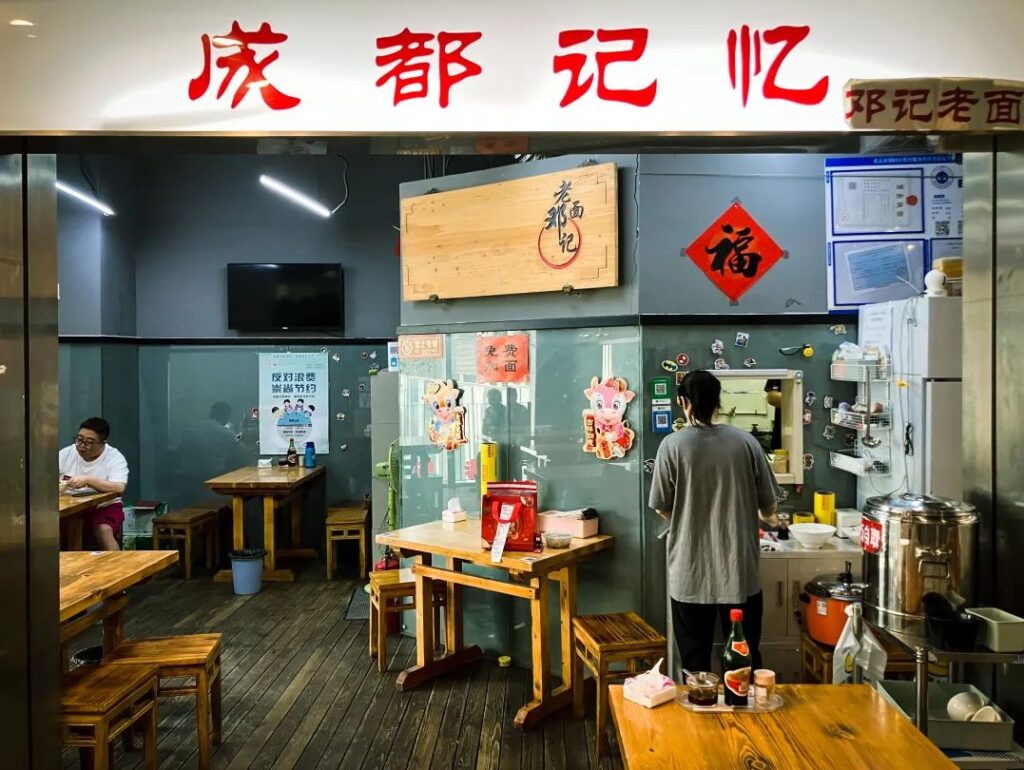
In my opinion, Sanlitun SOHO is Beijing’s “Kowloon Walled City.” The trendy and avant-garde exterior cannot hide the odd and lively atmosphere inside the building. When wandering around here, I always feel like the businesses exist in different dimensions: second-hand luxury goods stores are next to ear-cleaning and massage shops, while high-end clothing stores are adjacent to ramen restaurants. The term “cyberpunk” has been overused, but I can’t think of a better way to describe this place. Here, you’ll always find the unexpected.Deng’s Old Noodles is like a module embedded in a three-story building, with outdoor seating set up inside the building. Adjacent shops are either hair salons or pet stores, so you can imagine the complexity of the aromas. As the previous batch of diners departs, the background noise is the barking of dogs from the neighboring store. On the kitchen wall, there’s a sign that reads: “Free extra noodles.”
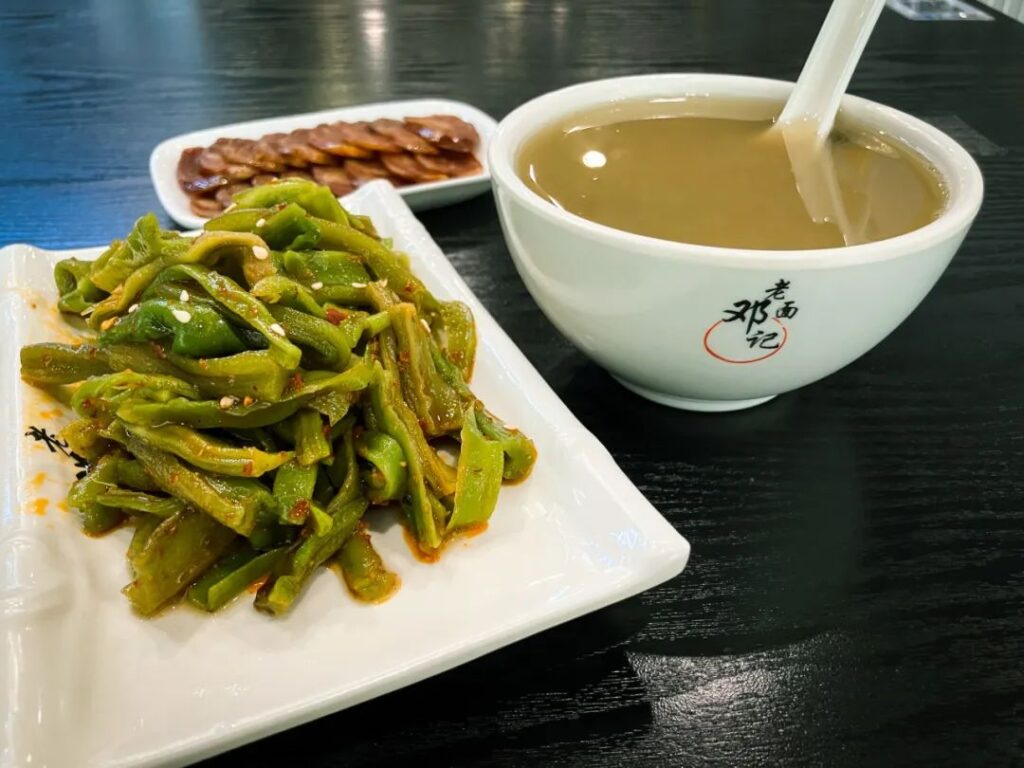

The main offerings are naturally noodles, followed by wontons and bell dumplings. Side dishes include tribute vegetables, crispy pork, and glutinous rice cakes, all standard fare for Chengdu snacks. My friend ordered Wanzha noodles, which I didn’t understand but respected. I was curious about the difference between Chengdu’s old noodles and Chongqing’s small noodles, as the signature dish is called Deng’s Old Noodles.
The food arrived quickly, with both bowls arriving simultaneously, each accompanied by a complimentary serving of shredded tofu. The Wanzha noodles were nothing special, just the standard combination. The base of the old noodles was similar to that of Dandan noodles, with the addition of crushed peanuts and minced meat, but with less sauce than what I had in Chengdu, making it drier. After mixing everything together and taking a bite, I felt a spicy and fragrant flavor with a subtle sweetness. Could this be the so-called “strange flavor noodles”?
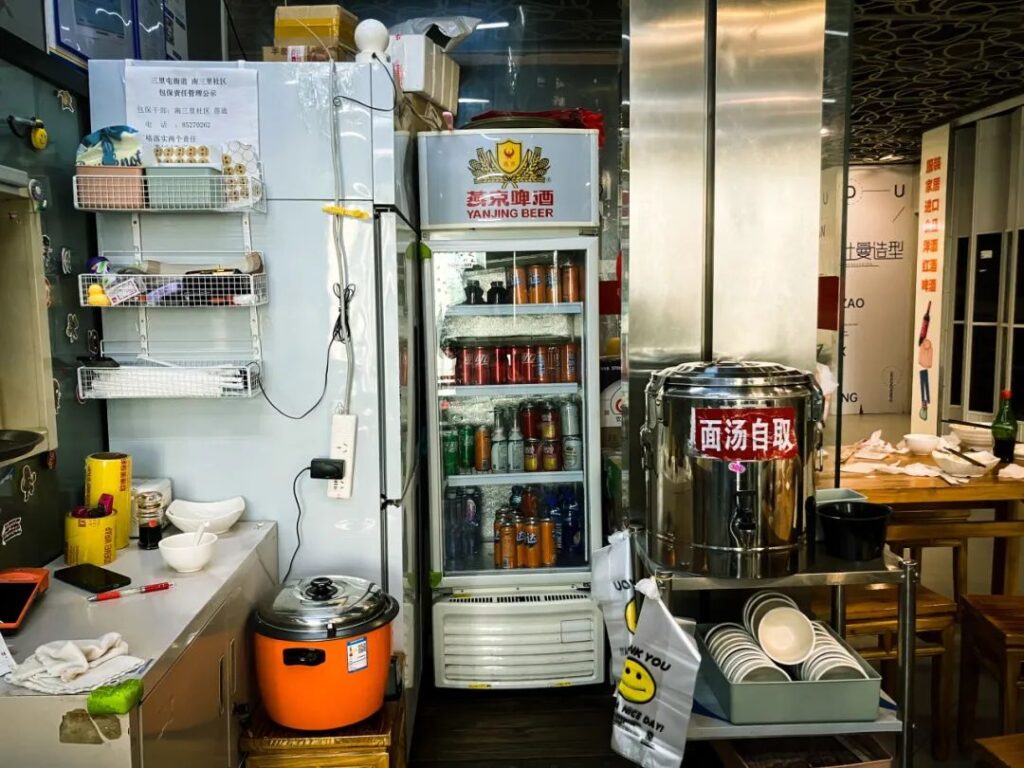
The more I ate, the more flavorful it became. Paired with sugar-coated tomatoes, don’t ask me why they served sugar-coated tomatoes, as I’ve never seen them in Chengdu snack shops either. Perhaps sugar-coated tomatoes can give the surrounding office workers a sense of home-cooked comfort. I ordered it because it somehow felt strangely familiar.
Two bowls of noodles for two people, plus cold dishes and side dishes, cost just over 50 yuan. I have to say, this cost-effectiveness is quite friendly for the working class. Walking out of the restaurant, it felt like we had completed a roadside picnic on the third floor of a CBD building. The lingering aroma in my nose and mouth fended off the indescribable complex scents of the building.
Huyuan Spicy Hot Pot
📍 SOHO Jiasheng Center, Borui Building
Baijiazhuang in Beijing is a place name that has been sliced in half by the Third Ring Road from south to north. It was once a natural village, but now the people living here are all city dwellers. Nearby stand three tall buildings: Jiaming Center, Jiasheng Center, and Borui Building. An old road runs through them, surrounded by old, dilapidated residential areas divided by the high-rises. The six-story brick houses from the last century and the newly erected buildings appear extremely incongruous when placed together.
Many such areas exist near Beijing’s CBD, where new businesses eagerly surround the residents.

Right on the roadside north of the Borui Building, there is a Chengdu-style restaurant called “Huyuan.” Next to it, there is a nameless Chongqing noodle shop, which is the real highlight. A friend recommended this shop, saying they had found the best spicy hot pot in Chaoyang District, but there was no specific location, so we had to identify it on site.
Street-side shops around commercial districts often live on borrowed time, so the owners don’t bother to come up with a name or decorate the place. “Four white walls” and stools are all the furnishings they have. But remember, the spicy hot pot is only available after 5 pm; otherwise, they only serve noodles.
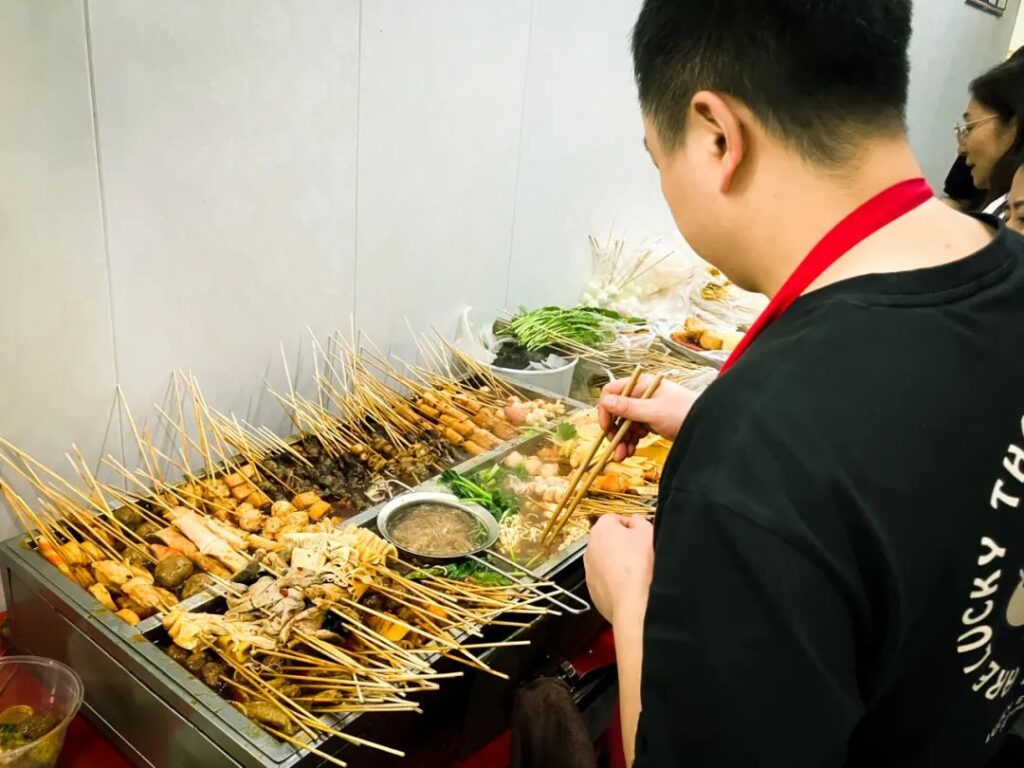
Tianshui spicy hot pot had its moment of fame, making this B-grade delicacy, which originated in Sichuan and was later improved in Northeast China, highly regarded among young people. Initially, it was just a simple street-side hot pot that people could eat on the go without wasting time for manual laborers, while the spicy and fragrant heavy flavor also helped relieve fatigue.
Nowadays, those chain-operated spicy hot pots are too common and lack novelty. However, the owner of this nameless small shop still stands alone in front of the “generous pot” to operate. The flavor is rich, and the ingredients are authentic, typical of a husband-and-wife shop. Large buckets of garlic water and sesame paste are self-serve, and the skewers cooked in the rich broth are spicy enough without dipping sauce.
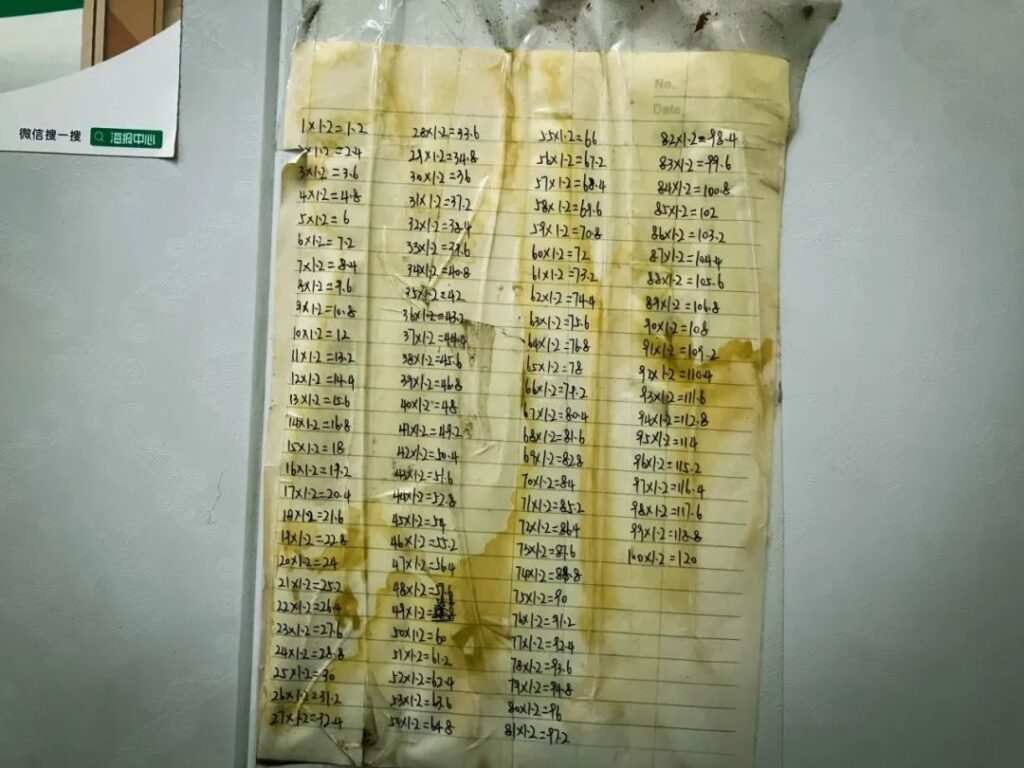
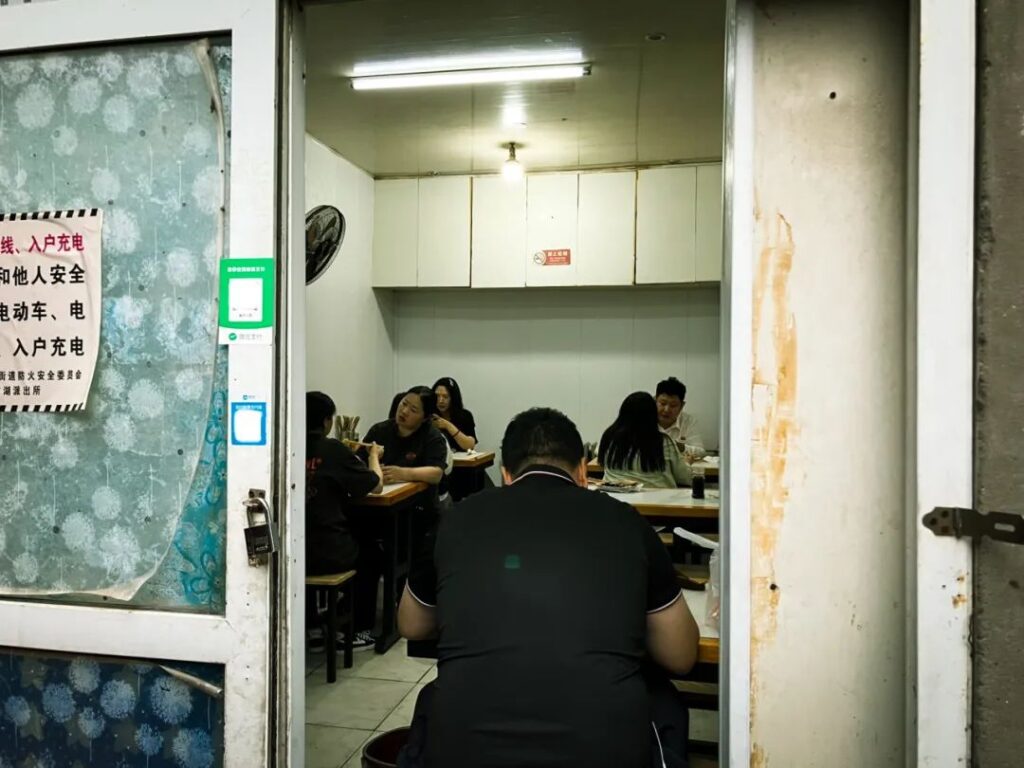
I always have a high opinion of such generous shops. The business principle is to put customers first, unlike some chain stores where you have to think about how to phrase your request just to get a worthless pack of ketchup from the staff.
The most exciting part of eating skewers is often the boss’s mental calculation after quickly counting the sticks, showing a kind of proficiency. But why bother with this trivial matter? They might as well just stick the multiplication table on the wall.

I’ve never had any special feelings for spicy hot pot; the important thing is to enjoy the atmosphere. When the shop is crowded, the boss will open the back door and put folding tables in the alley. The spatial shift also pulls time back, “In the early 2000s, spicy hot pot by Tuanjiehu Lake was two mao per skewer.” The motion-sensing light at the door flickers with the sound of chatter.
I really want to go back to more than ten years ago, to that night when I ate skewers with friends outside a Xinjiang restaurant, taking advantage of the street lights.
Xinyue Zhai
📍 Beijing Telecom Building, China National Offshore Oil Corporation Office Building
In the Douban Hutong behind the China National Offshore Oil Corporation Building and the Telecom Building on the East Second Ring Road, there is a restaurant so small that it’s hard to notice even if you pass by. As a street-side restaurant, Xinyue Zhai is easy to miss, but fortunately, there is a landmark building next to it: Nandouya Mosque. Look to the north, where the surroundings are covered with vines, and walk inside.
Perhaps because the small restaurant is so tightly wrapped by the greenery outside, it’s only when you step inside that you realize Xinyue Zhai is built within the mosque’s walls. There are five or six tables, and the dining area is extremely narrow. Even so, it still features an open kitchen where dishes are freshly stir-fried.
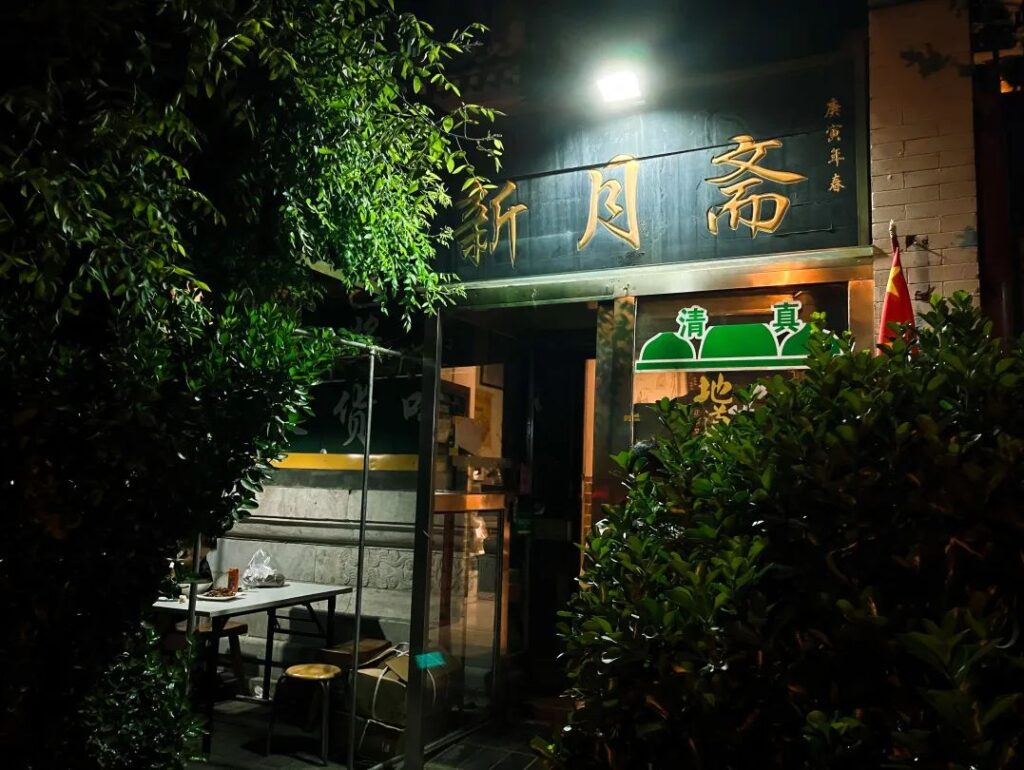
The names of many Muslim restaurants in Beijing often include the character “zhai,” such as Chai’s Flavors Zhai and Jingxiang Zhai. In the “Shuowen” dictionary, “zhai” is explained as “abstinence and purity,” referring to the ancient people’s practice of fasting and necessary self-purification before religious ceremonies. Later, it was extended to mean vegetarian food. Calling a restaurant a “zhai” adds a layer of religious sacredness.
Many people treat food as a kind of belief, not only in the pursuit of deliciousness but also in adherence to certain rules. For example, at Xinyue Zhai, you absolutely cannot buy alcohol, which is the shop’s adherence.
Jing-Dong meat pancakes, vinegar-braised wood ear mushrooms, and pot-collapse lamb are the three dishes listed on the review website. Following the neighboring table, we also added a dish of scallion-fried kidneys; all four dishes are meat.


Both the vinegar-braised wood ear mushrooms and the pot-collapse lamb contain eggs, but the word “egg” is not mentioned. It is said that in the old days, Beijing’s dignitaries loved to eat Lu cuisine, and vinegar-braised wood ear mushrooms were one of the representatives. However, the eunuchs were taboo about the word “egg,” so they changed it to “muxu,” which looks similar to “wood ear.” Later, it became the colloquial term “muxu.” As for “pot-collapse,” it is a cooking method that resembles a pizza. Both dishes have a thick, starchy sauce, typical of northern Chinese dishes that are served with rice.
The scallion-fried kidneys were not ordered in vain. The stir-fried lamb kidneys have a different cooking method and flavor from the previous two dishes, but to be honest, the chef is really generous with the ingredients, and the flavor is strong enough. As for the beef-filled meat pancakes, there’s nothing much to say; they are standard and pleasingly thick.
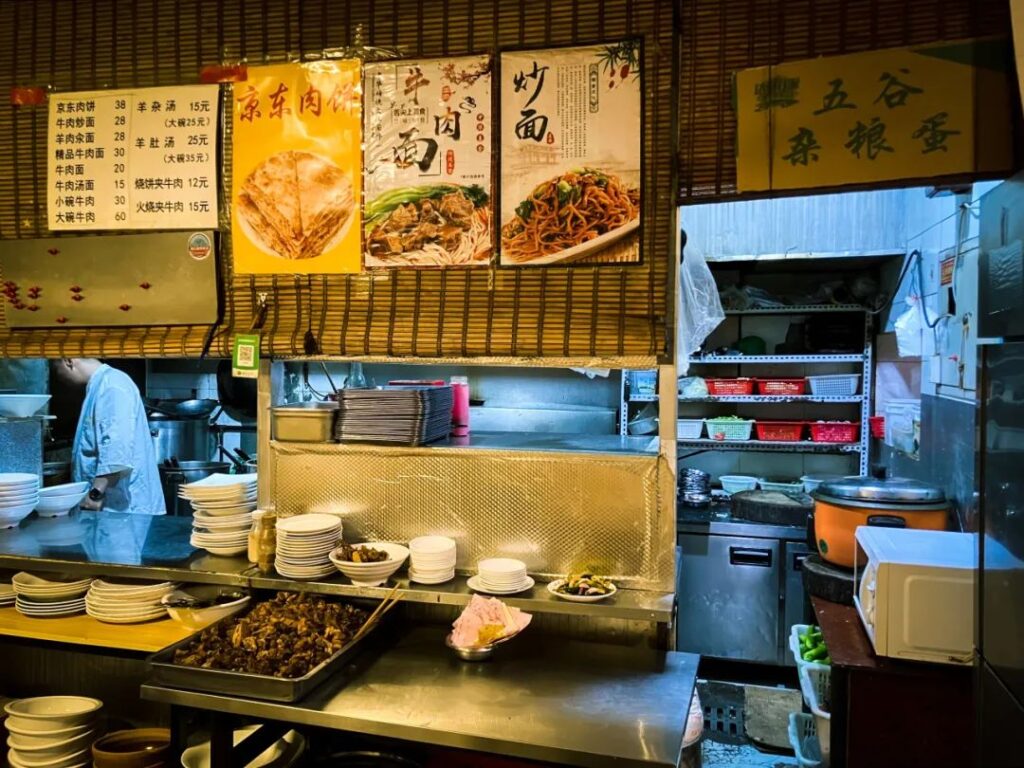
It wasn’t until the second half of the meal with my friend that I realized we hadn’t even ordered a cold dish. So we added a dish of onion and green pepper salad, not for any other reason but to relieve the greasiness.
We found that the customers all ordered heavy-flavored dishes to go with rice, high in oil and strong in taste, filling their mouths and leaving no room for chatting. Before leaving, I looked up and saw a piece of calligraphy: “Why not carry a hook, and collect the fifty states of Guanshan. Please, sir, temporarily ascend the Lingyange Pavilion, which scholar could become a lord of ten thousand households?” It’s really spirited. It’s right not to let people drink alcohol.
Hejiang Yongchun Tofu Pudding Rice
📍 Lufthansa Center, Shokai Plaza
In my mind, tofu pudding rice from the Sichuan-Chongqing region has always been a unique existence.
Sichuan cuisine in Beijing, from appearance to taste, is all about spiciness and fieriness, but tofu pudding rice is different. At least before the tofu pudding enters the dipping sauce, it is so fresh and clear. When eating, you can’t put the large pieces of tofu pudding into the sauce dish in one go, and you can’t sprinkle the dipping sauce into the tofu pudding.
The dipping sauce for tofu pudding rice is like hot pot; the more you eat, the spicier it gets. So when you get to the middle and later stages—for a vegetable-loving Sichuan food enthusiast like me—you can even take advantage of the spicy pain that hasn’t dissipated in your mouth, wrap the tofu pudding with white rice, and consume it directly. Just pretend the dipping sauce doesn’t exist.
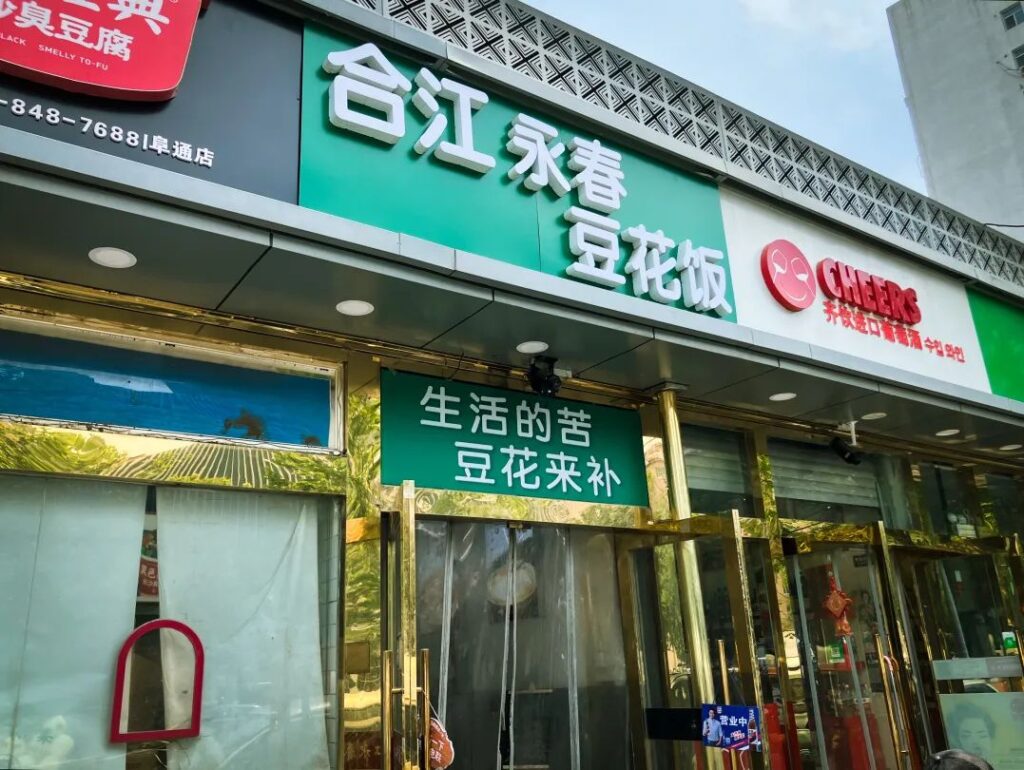
Thinking back, the last time I tasted authentic tofu pudding was around 2017. Can you find authentic tofu pudding rice in Beijing? I used to think it was impossible. But recently, I discovered a small shop across from the Lufthansa Center in Wangjing, with a signboard that boldly proclaims: We specialize in tofu pudding rice.
The 14-yuan tofu pudding is served in a large bowl used for noodles, which immediately impressed my friend and me. The portion I had eaten in Chongqing before was actually this size. I don’t know if I had forgotten or if my appetite had decreased, so I hurriedly asked the waiter to take back one bowl.
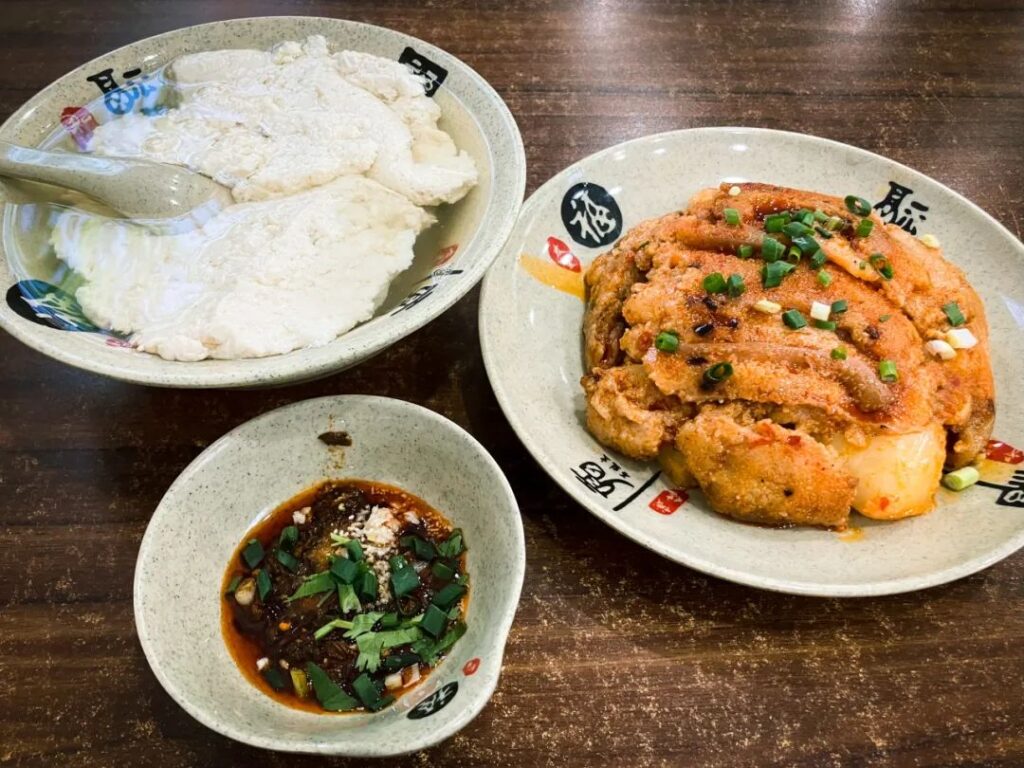
The tofu pudding is smooth and tender, and the dipping sauce is fragrant and spicy, with a strong aftertaste that made me sweat profusely. In addition to the tofu pudding, we ordered salted braised pork belly and water spinach based on the ranking on the review website. The braised pork belly is actually preserved vegetable with pork belly, salty and slightly sweet, soft and not dry. I have to say, with different cooking methods, the taste of pork belly can be vastly different.
However, I still prefer the water spinach. The Sichuan cooking method, which emphasizes seasoning, makes even such a bland leafy vegetable go well with rice. “Goes well with rice” is my highest praise for a dish. As a member of the working class, I don’t think this is embarrassing.


I’ve found a pattern: in delicious restaurants, the boss must be watching over the shop. Restaurants where the boss is absent are probably not that delicious. McDonald’s is an exception; I’m not trying to be contrary. So we added more dishes like fiddlehead fern and steamed pork with rice flour, eating to our heart’s content.
A man came into the shop wearing a t-shirt, shorts, and slippers. He clearly wasn’t coming from work at the Lufthansa Center and seemed to be a resident from the surrounding area. He ordered a tofu pudding rice set meal (tofu pudding + rice + side dish), and the dish was immediately served. He then told the boss, “The set meal includes rice, so could you please cancel the separately ordered bowl of rice for me?”
They are all people who know how to live life!
Songli Restaurant
📍 Central Radio and Television Tower, CITIC Tower
On the way home from work, I can always see its red glowing signboard from the bus, with the China Zun tower in the background. The visual contrast is striking, especially at dusk. The restaurant is flanked by old, dark residential buildings on both sides. The skyscraper in the background isn’t dazzling; in the foreground, only this Songli Restaurant shines the brightest.
Songli Restaurant is extremely close to the CCTV headquarters, the “Big Underpants,” almost right below it, adjacent to the Xinjie Dayuan residential area. It specializes in Sichuan and Hunan flavors. The restaurant is a single-story building with gray walls and a signboard on the roof. The plastic-steel residential doors and windows suggest no decoration at all.
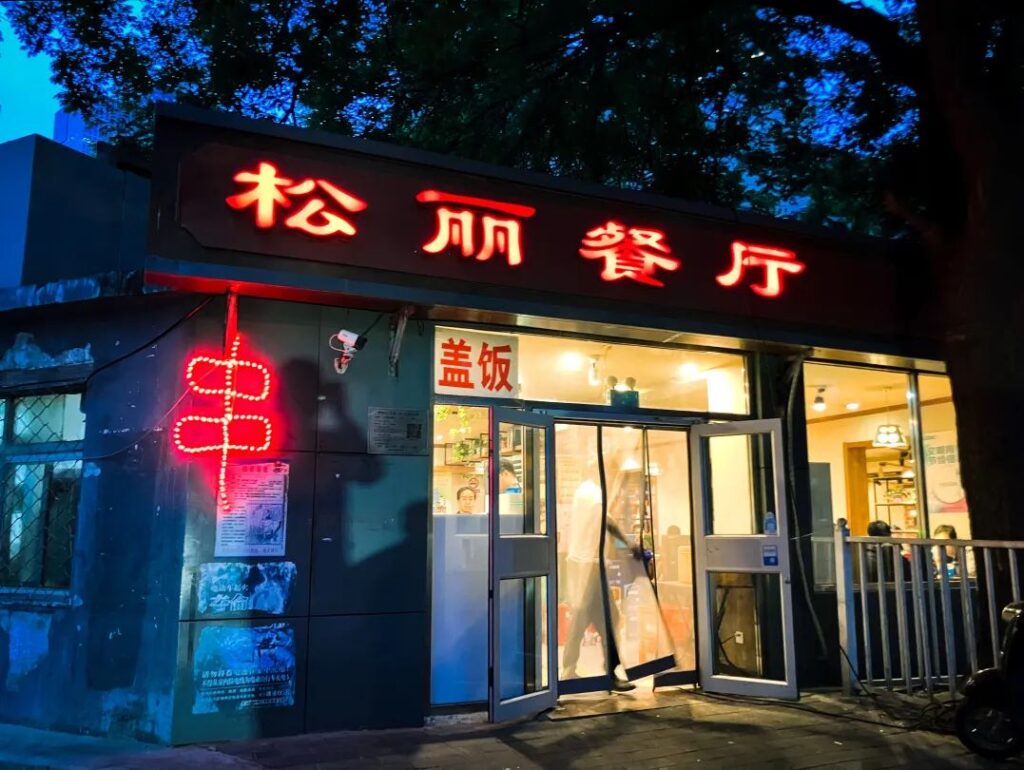
At noon, the surrounding seats are probably all occupied by media people. I guess the CCTV cafeteria must be hygienic but inevitably lacks the “dirty stall” vibe. For them, eating might be a minor matter; leaving the office to change the serious atmosphere is more important.
The braised pork rice I ordered hasn’t arrived yet. Some tables are discussing how difficult it is to advance projects and balance with clients… Others are talking about family conflicts… I can sense their fatigue from the conversations. But anyway, having lunch outside the office is a choice beneficial to mental health.
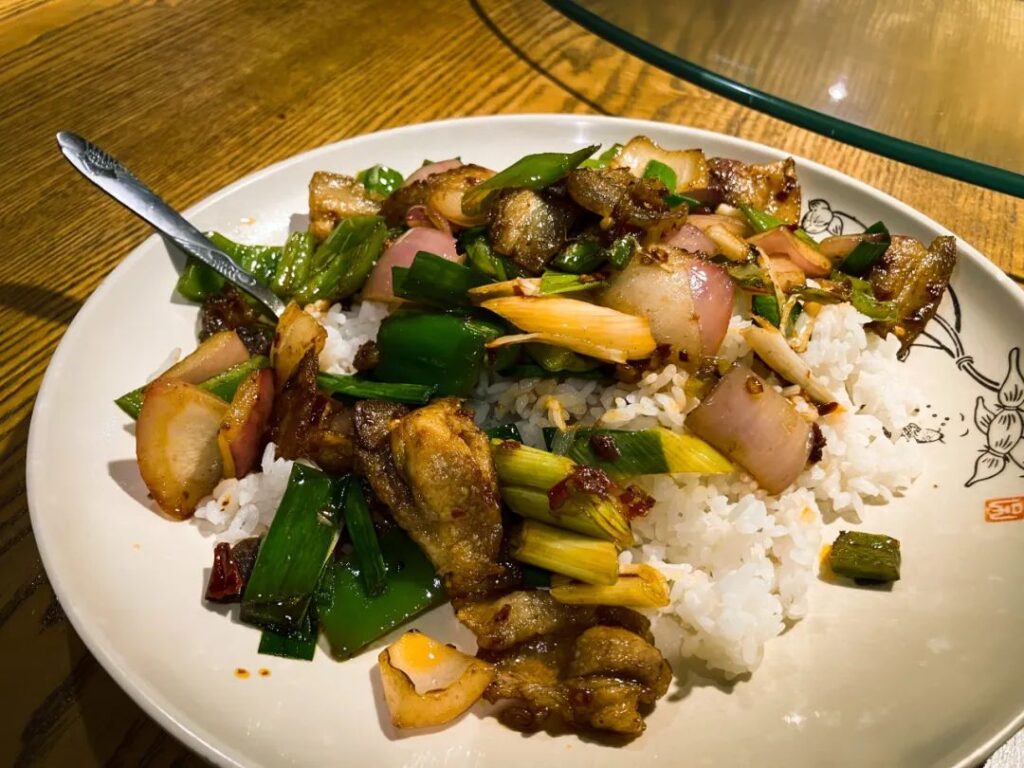
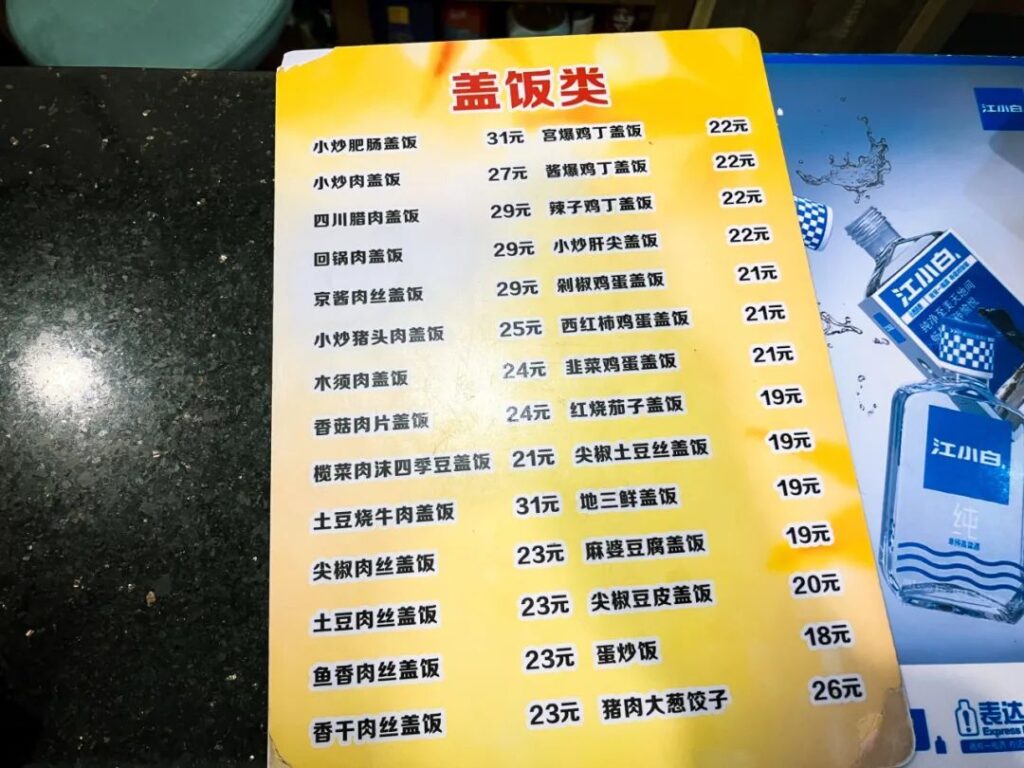
The rice bowl doesn’t have much starchy sauce; the rice is rice, and the dish is the dish, quite distinct. If you mix them together, it might reduce the appetite a bit. When the rice and dish have a sense of layering, the mouthfeel will be better, and it will be more visually pleasing. So, when eating rice bowls, my personal choice is not to order dishes with starchy sauce, which will appear a bit more elegant.
Of course, isn’t the “sauce” in “braised rice” referring to the starchy liquid? That’s right, mixing the dish’s broth with rice can also be very good. However, when facing a generous chef, you might feel thirsty after eating (in Beijing dialect, it means getting parched).
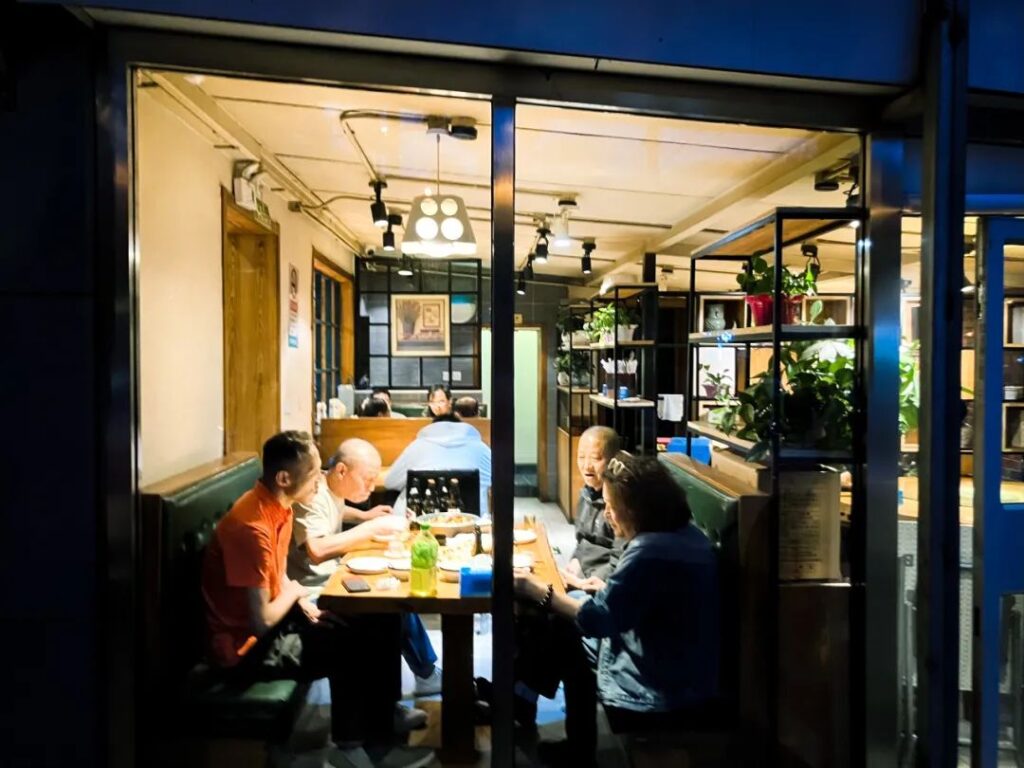
This braised pork is the kind I like. The middle part of the meat is soft, springy, and delicious, while the edges are crispy and fragrant. Each slice of meat stands up vigorously, rather than lying limply on the rice. Although twice-cooked pork is a dish that has been processed twice, it should still have a sense of vitality.
Xinjie Dayuan was the dormitory of the Beijing Automobile Manufacturing Factory in the 1960s, with complete supporting facilities, including a cinema, bathhouse, hospital, and cafeteria. As time passed, the workers’ cafeteria is gone, but fortunately, some people’s Songli Restaurant is still here.





